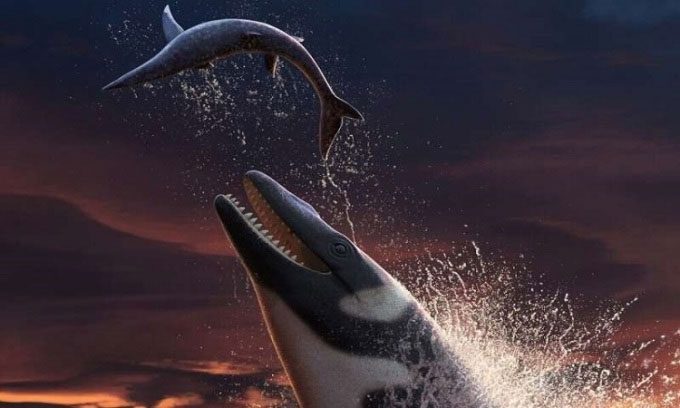A newly discovered species of mosasaur features jaws and teeth resembling those of the orca, with a body length of up to 9 meters, inhabiting the seas at the end of the Cretaceous period.
Researchers have identified a giant new species of mosasaur named Thalassotitan atrox, which is part of the top-tier predatory animals. With its massive jaws and teeth similar to those of orcas, Thalassotitan preyed on other marine reptiles such as long-necked lizards, sea turtles, and various other mosasaurs.

Reconstruction of Thalassotitan atrox. (Photo: Andrey Atuchin)
At the end of the Cretaceous period, approximately 66 million years ago, real sea monsters roamed the oceans. While dinosaurs thrived on land, the seas were dominated by mosasaurs, enormous marine reptiles. These creatures were not dinosaurs but marine lizards that could grow up to 12 meters long. They are distant relatives of modern monitor lizards and iguanas.
Mosasaurs resembled Komodo dragons with flippers and shark-like tails. They grew increasingly larger and diversified over the last 25 million years of the Cretaceous, occupying niches previously held by long-necked lizards and fish lizards. Some species evolved to feed on smaller prey such as fish and squid, while many others specialized in crushing shellfish and mollusks. The newly discovered Thalassotitan evolved to consume all other marine reptiles.
The skeleton of Thalassotitan was excavated in Morocco, about an hour’s drive from Casablanca. Near the end of the Cretaceous, the North African region was submerged under the Atlantic Ocean. Nutrient-rich waters from the deep sea nourished plankton, which served as food for small fish, large fish, mosasaurs, and long-necked lizards. This food chain contributed to the massive growth of Thalassotitan.
Thalassotitan had a skull measuring 1.4 meters long and a body length of up to 9 meters, comparable to that of an orca. While most mosasaurs had long jaws and slender teeth for catching fish, Thalassotitan possessed a wide, short jaw with large conical teeth similar to those of orcas. This adaptation allowed them to bite and tear apart large prey. These features indicate that Thalassotitan was an apex predator, situated at the top of the food chain.
The teeth of Thalassotitan were often broken and worn down. It is likely that they attacked other marine reptiles, resulting in chipped and worn teeth during the process of tearing apart their prey. Some teeth were even broken down to the root.
The research team, led by Dr. Nick Longrich at the Milner Centre for Evolution at the University of Bath, even discovered the remains of Thalassotitan’s victims. Fossils found in the same sediment layer showed signs of acid damage, with bones and teeth being corroded. These fossils included a carnivorous fish, a sea turtle, the head of a half-meter long long-necked lizard, and the jaws and skulls of at least three other mosasaurs. Thalassotitan likely digested these remains in its stomach before regurgitating the bones.





















































